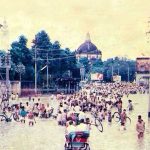The Kalai Work
Gleams Rejuvenated
Technology plays a vital role in our life and now a days from the start of the day till the time we sleep we are totally dependent on it. We are so much reliant on technology that often I think about how the things are going to turn out to be and the consequences we are yet to register, after totally being dependent on the technology. If we talk about the impact of technology on our kitchenware so definitely there is a lot to talk about. Earlier kitchenware of copper and brass were used but with the rapid intrusion of stainless steel and aluminum vessels brass and copper vessels vanished from the modern day kitchen.
Brass and Copper kitchenware requires tin-plating after six to eight months and the person who does this Re-tinning is known as ‘Kalaiwala’. The kalaiwala’s work is bit like knife grinders. Earlier when brass and copper ruled the kitchen they were earning a good amount of money but after the intervention of stainless steel and aluminum they had somewhat lost their utility in the society and now they are struggling hard in order to earn their living. So we can say that an old profession i.e. the kalaiwala’s paid a very heavy price for industrialization and technological development.
The metal was used in ancient times because it was the only one available and also because of its sheen. But ancient India had its own practical scientific wisdom in place and this is where ‘Kalai’ comes into play. A Kalaiwala moves on a bicycle with a blower, charcoal, zinc strips and other chemical used for ‘Kalai’ (re-tinning or galvanization). People used to respond to his pitch calling of kalai by signaling him to stop. For children it was an act full of fascination; they hover around him to see how their brass and copper kitchenware turned shining white at a single stroke. The process of ‘Kalai’ involves washing first the copper utensil with caustic soda to rid it of any surface impurities such as dust. The next step is washing it with an acid that contains the gold purifying compound ‘Sufa’, a salt and another element. It is then immediately wiped clean otherwise it might bear a mark. The ìKalaiwalasî dug a pit in the ground and prepared a temporary blast furnace, airing it with bellows. They then heated the utensil, blasting it off and on and sprinkled a miraculous component ìNausadarî. The powder is rubbed onto the utensil with a cotton cloth, which gives out deep white smoke and a peculiar ammoniac smell. ‘Nausadar’ powder or ammonium chloride has some very beneficial properties that can advertise kalai’s advantage. After that the utensil is then dipped into a bucket full of water. The sudden contact of the hot utensil with the water creates a shrill and sharp sound that dims with the utensil recovering its normal temperature.
In Lucknow, the ‘Kalai’ work is divided between 5-6 shops scattered about the main Yahiyaganj market and nearby area. A few can also be found in Chowk. In dark, dingy, old edifices that could belong comfortably to the last century, as in fact they do, workers perform the interesting task of donning a utensil fit with kalai. Though kalai does not enjoy the same market demand or popularity as before. The reduction in this work is of course linked with the lessened use of copper utensils which have been replaced by stainless steel, which is lighter and a more stable cookware while copper utensils can be deemed to be toxic, if unlined and the metal tends to react with acidic foodstuff which can cause nausea, vomiting and diarrhea. It is also heavier though its conducive heating serves well for cooking definitely.
It is still practiced in sufficiency to suit the workmen. Your demand to get kalai done in any utensil shop would be promptly served, at least in old Lucknow, accounting for its prevalence.
Haaji Nawabu, who is also known as ‘Munna kalaigaar’ has a shop in Yahiyaganj, says, “The Nausadar powder is becoming more expensive, since its demand is increasing as people are realizing its benefits. A forty or fifty rupees is charge for this swift job on a single utensil.” Nausadar with its health benefits emits such harmful fumes, they are slow poison to lungs and the pungent smell in the shop is impossible to tolerate for anyone.
Talking more on this distinct art he adds, “You see, our forefathers with their cleverness were aware of the health problems and build up practices countering the harmful effects of our trade. What we do is incorporate such a nutritional combination, proteins etc. in our diet as it fights the bad effects and makes our immune system stronger too. So a lot of meat, biryani and chicken are cooked in our household in a routine”. That’s what they believed in that could cancel the sad harms of their work.

The pungent fumes in the work place evince the downside of this work, the disturbing unnatural greened nails of the workers. The constant contact with acid, soda and these substances has the cording, roughening effect on the skin of their hands and their fingernails bear alarming testimony to the nature of their tasks. Such are the perilous hazards of this simple piece of work.
However Haaji Nawabu is positive on the future of this trade though he admits that no one would want to take it up in the face of the negative effects, but if these are handled or done way with, maybe the process, if not modernized a bit cleansed for the workers, the health benefit, as promulgated by men of medicine, is sure to make it popular and expand the business. It is an intricate and beautiful little craft, worthy of protection.
On our pursuit to explore this distinct artistic work we reached out to Eram Sabi, a resident of the old city. After being asked about the different facets of this dying artistic work she says, “We still visit the Hakim in our area and his diagnosis and remedies always work. It was on his recommendation that we started using a copper jug for water. The kalai process employs Nausadar that is very good for digestion. So even in modern times we like to abide by these old world cures that are so easy and efficient”.
Copper itself has many amazing benefits to offer. It has anti-microbial properties. Drinking water from a copper container is especially recommended. Skin disease such as vitiligo is combated by stimulated melanin production, aging can be reduced by the production of collagen, a connecting tissue, and anemia caused due to copper deficiency is also helped. But excess consumption can also be harmful to liver as balanced is beneficial to it, so one may consult a doctor before using copper utensils.
If we still continue to ignore all such artisan and their craftsmanship no doubt the art and science of Kalai and other fascinating art form of our childhood days might become extinct. So what we need to do is that we should utilize their traditional skills in new ways to generate fresh ideas and eye catching new products.
Satyendra Singh
Writer is a teacher by profession.
(Published in The Lucknow Observer, Volume 2 Issue 18, Dated 05 September 2015)




